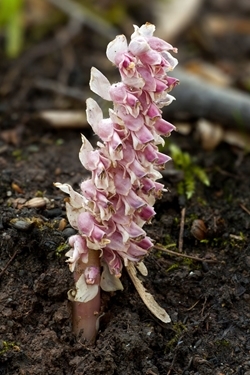Toothwort
 Many of Britain’s spring woodland flowers are dainty and colourful, adding pretty accents to the tapestry of tangled greens in the ground layer. One such flower that emerges at this time of year however, toothwort (Lathraea squamaria), is a bit of an oddball amongst the delicate bluebells and anemones. Looking like a stack of vertebrae protruding up through the woodland soil, toothwort is one of our most fascinating and unique woodland flowers.
Many of Britain’s spring woodland flowers are dainty and colourful, adding pretty accents to the tapestry of tangled greens in the ground layer. One such flower that emerges at this time of year however, toothwort (Lathraea squamaria), is a bit of an oddball amongst the delicate bluebells and anemones. Looking like a stack of vertebrae protruding up through the woodland soil, toothwort is one of our most fascinating and unique woodland flowers.
Toothwort is a parasite, and it keeps company with a small handful of flowering species in Britain that have evolved to draw all their sustenance from other plants. You might have seen broomrapes and yellow rattle before – these are much more common parasites that are often seen in flower-rich areas and meadows.
Toothwort has a fairly broad distribution but is more often found in central England than other parts of the country. You’ll only find it in deciduous woods, hedges and wetland edges, at the bases of particular trees and woody shrubs that its roots can suck nutrition from – most commonly hazel, elm, beech and lime. Despite how widespread its host plants are, toothwort is a special and rare find!
Its scientific name, Lathraea is derived from the Greek word for clandestine and secret – because it spends most of the year under the ground. When it is ready to flower in late spring, it emerges above the soil much like a mushroom would. All parts of the 10-20cm tall flowering spike are softly hairy and white in colour, tinged with pink. The clustered flowers resemble an orchid, but it is named toothwort because it does eerily resemble a stack of teeth. Another of its names, ‘corpse flower’, may be a nod to the fleshy colours, but rumour has it this nickname refers to observations of the plant growing in soil above buried bodies.
Toothwort is completely lacking in chlorophyll, the green pigment that allows plants to farm energy from sunlight. To get its nutrients, it sinks special suckers into the roots of the host plant, rather like a vampire! Bumblebees and ants are attracted to the flowers, but it is mostly self-pollinating, and sometimes does not need to flower above ground at all to persist.
In mid-summer, the flower spike withers down, having dropped any ripe seeds onto the surrounding soil. It then withdraws its suckers, retreats and rests for the autumn and winter. It is sedentary, persisting in the same location throughout the years, so if you are lucky enough to find a patch you can go back to see its annual emergence.
For all the talk of teeth, corpses and vampire suckers, I think this is a fabulous little member of our native woodland flower community, and I look forward to making my first encounter soon!
Jess Brooks
Advisory
Photo credit: Jörg Hempel